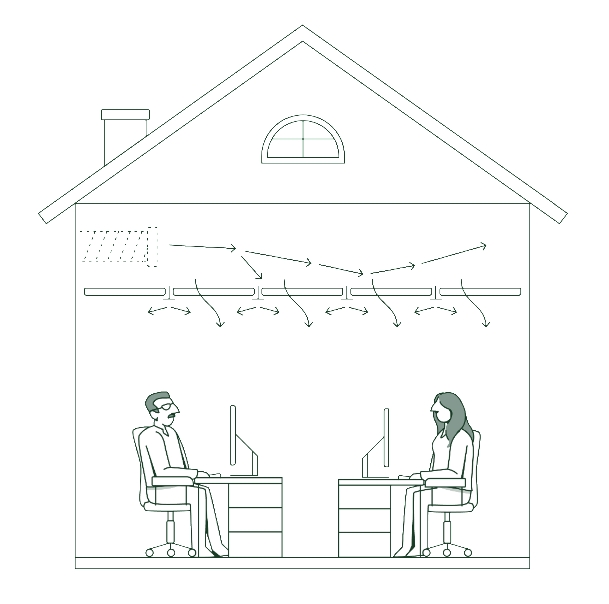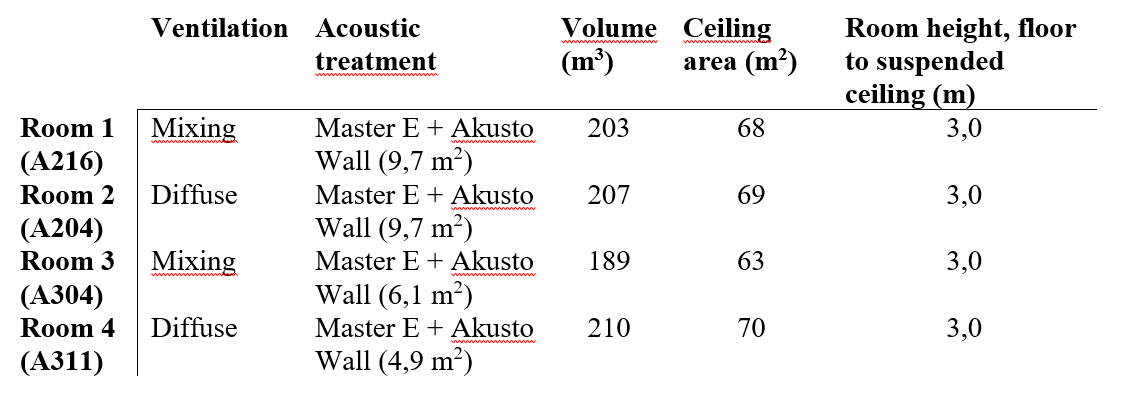
At Ekenäs School in Eslöv, Sweden, we compared four classrooms with almost identical acoustic treatments but differing in the type of ventilation system used. We wanted to know if diffuse ceiling ventilation can offer a quieter as well as more comfortable, sustainable and cheaper solution.
Background: diffuse ceiling ventilation
Diffuse ceiling ventilation allows air into the room through the naturally occuring gaps in a suspended ceiling as opposed to via diffuser panels. By removing the ducts and diffuser panels, this turns the entire ceiling into a diffuser.
This limits the directional airflow in a room and improves thermal comfort for occupants and creates a more homogenous distribution of air in the room.
Additionally, because less materials are used, the resulting solution is cheaper and more sustainable. To read more about the differences in benefits between these respective ventilation systems, please see this article.

Both systems are compatible with optimal acoustic solutions for schools; namely, an acoustically active suspended ceiling which provides the largest possible area of sound absorption in a learning environment. However, with a diffuse ventilation system, the lack of a need for diffuser panels means that the entire ceiling can be acoustically active.
Research aim
The aim of the study was to measure whether noise (sound pressure level) was lower in the rooms with diffuse ceiling ventilation, while controlling other acoustic parameters. Differences in sound pressure level were expected because air-flow through the ducts and diffuser panels into rooms with mixed ventilation often creates the sound of rushing air, adding the burden of noise to the sound environment.

Measurements were taken in two of the four rooms in this experiment had diffuse ceiling ventilation installed while the remaining rooms had traditional mixing ventilation. All rooms had a 40mm suspended ceiling plus a sound-absorbent wall panel. A more complete set of room parameters including acoustic treatment used is provided on Table 1 below.

Equipment and measurement procedure
The measurement equipment included an omnidirectional loudspeaker (B&K Type 4292), an omnidirectional microphone (4188-A-021), an amplifier (B&K), a microphone amplifier (B&K TYPE 1704-A-002), and measurement software (Dirac version 6).
All measurements were made according to room acoustic standards standards SS-EN ISO 3382-1, SS-EN ISO 3382-2 och SS-EN ISO 16032:2004. Recommendations for reverberation time were made according to SS 25268:2007+T1:2017.
Results
Table 2 shows the basic acoustic parameters between the rooms including reverberation time (T20), speech clarity (C50) and sound strength (G). These differed only slightly between rooms.

Table 3 shows the differences in measured sound pressure level between the mixing and diffuse ceiling ventilation rooms. As expected, sound pressure level shows an interesting departure that is most likely due to the difference in ventilation system. The noise level was 2-3 dB(A) lower in the rooms with diffuse ceiling ventilation. Notably, 3 dB corresponds with halving of the sound energy in the room [1].

Conclusion
In conclusion, this indicates that the benefits of diffuse ceiling ventilation are not only for thermal comfort. Reduced sound pressure levels by up to half in the classrooms measured are likely to provide additional benefits for communication and speech perception over and above the optimized acoustics in the rooms measured.
Having an overall quieter system means that children that are at risk of learning deficits due to noise are likely to benefit. For example, children learning in their second language, children with hearing losses or learning challenges that are particularly susceptible to the effects of sound (including being on the autism spectrum, having an auditory processing disorder or ADHD). To learn more about the impact of noise in education on various groups in the classroom, please click here).
For any questions about the research study or the topic more generally, please write to [email protected].
Sources
[1] Kuttruff, H. (2016). Room acoustics. Crc Press.

